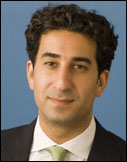Source: House Committee on Foreign Affairs
 The Obama administration faces the difficult task of reconciling when and how to deal with a disgraced regime which presents urgent national security challenges, while at the same time not betraying a popularly-driven movement whose success could have enormously positive implications for the United States. In testimony before the House Foreign Affairs Committee, Karim Sadjadpour explains the implications of Iran’s post-election tumult, and the best course for U.S. policy makers to take in the short-term.
The Obama administration faces the difficult task of reconciling when and how to deal with a disgraced regime which presents urgent national security challenges, while at the same time not betraying a popularly-driven movement whose success could have enormously positive implications for the United States. In testimony before the House Foreign Affairs Committee, Karim Sadjadpour explains the implications of Iran’s post-election tumult, and the best course for U.S. policy makers to take in the short-term.
The Situation in Iran:
- The Islamic Republic of Iran has ceded any pretensions of being a Republic. If the Ahmadinejad government maintains power, the country will be ruled by a small cartel of hard-line clerics and nouveau riche Revolutionary Guardsmen who reflect not only a relatively narrow swath of Iranian society, but also a narrow swath of the political elite.
- By defiantly supporting Ahmadinejad, Supreme Leader Ayatollah Ali Khamenei has exposed himself as a petty partisan and undermined his legitimacy as the undisputed leader of the country. Once sacred political red lines have been crossed in recent weeks; for the first time citizens have begun to openly challenge Khamenei with chants of “marg bar dictator” i.e. death to the dictator.
- At their peak the demonstrations in Tehran included as many as three million people, representing a diverse socio-economic swath of society and often led by women. The opposition’s primary challenge at the moment is that its leadership and brain trust is either imprisoned, under house arrest or unable to communicate freely. Despite continued popular outrage, at the moment there is no leadership to channel that outrage politically.
- The current scale of repression has been costly for the regime. Politically, fissures have widened among the regime elite. In the last week alone former presidents Hashemi Rafsanjani and Mohammed Khatami have challenged the legitimacy of the election. The financial costs of maintaining martial law, overflowing prisons, and media and communications blackouts are also significant for the government. Given the decline in oil prices, the current scale of repression will prove difficult to sustain for a long period.
U.S. Policy Recommendations:
- Wait until the dust settles to engage. Premature engagement runs the risk of demoralizing the opposition and implicitly endorsing the election, thereby tipping the balance in favor of the hardliners. And the benefits of immediate engagement are negligible because Tehran is still in disarray.
- Avoid making any military threats. Based on recent experience, there is good reason to believe that not only would Khamanei and Ahmadinejad not be cowed by this rhetoric but also they would actually welcome U.S. or Israel strikes as a way to unite squabbling political factions against a common threat and keep agitated Iranian citizens preoccupied with foreign quarrels.
- Condemn human rights abuses by the Iranian government. Recent history has shown that outside pressure and condemnation works, as the regime incurs no costs for its egregious human rights abuses when the world remains silent. One practical way of helping the cause of human rights is to help ease the communication’s embargo that Iranians are currently experiencing. Given the absence of foreign and domestic media, the role of everyday citizens bearing witness to events—whether via video phone or even simple email or blog communication—has become critical.
- Don’t underestimate the magnitude of this moment. While the type of change Iranians seek may continue to prove elusive for months, if not years, the United States should not underestimate the size, strength, maturity, and resolve of this movement, nor its enormous implications. While this movement must be driven by Iranians themselves, it should remain a U.S. foreign policy imperative not to do anything to deter its success or alter its trajectory.





